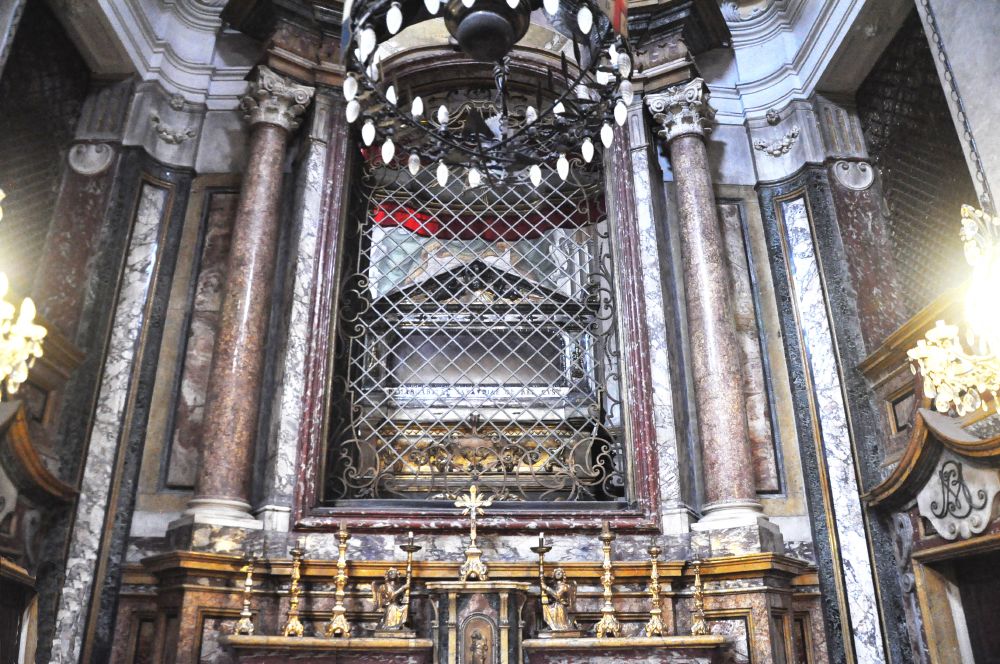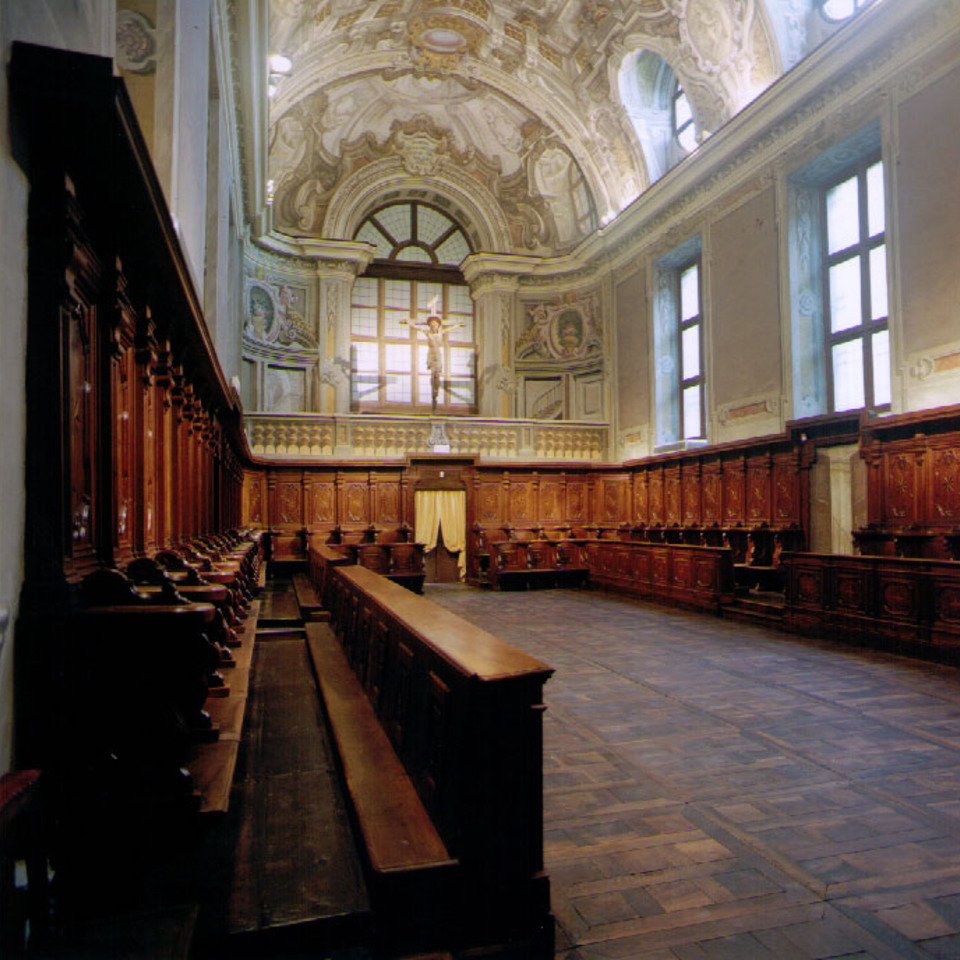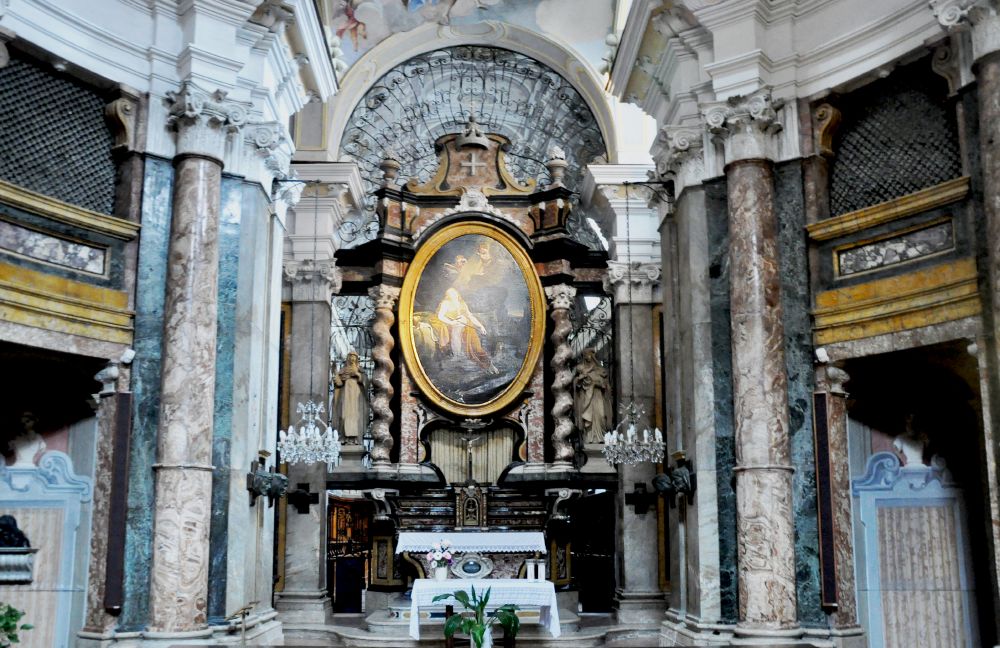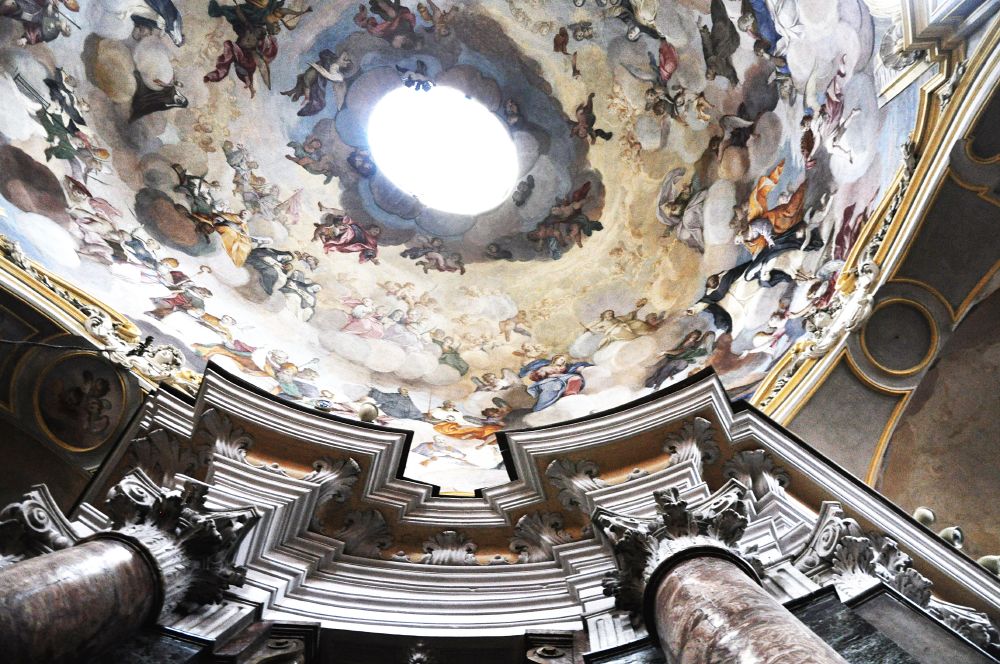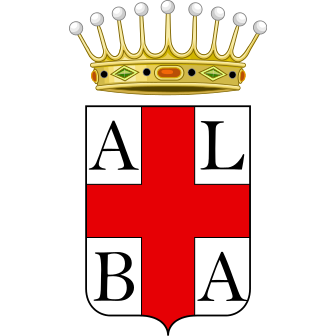
Business Hours
Contacts
Closing Day
Holidays
The sacred building stands at the crossroads of Via Vittorio Emanuele (“Maestra” street) and Via Paruzza, on the site where the church of the monastic order of the Humiliati, also named after St. Mary Magdalene (or Mary of Màgdala, a disciple of Jesus Christ, perhaps first evangelized French Provence and then devoted to hermitage), originally stood.
In the Middle Ages, the urban block (later completely occupied by the Dominican convent) included the convent house of the Umiliati (“domus Umiliatorum Albe“), the commendation of St. Anthony Abbot (church and hospital documented from 1343) of the order of the Antonians.
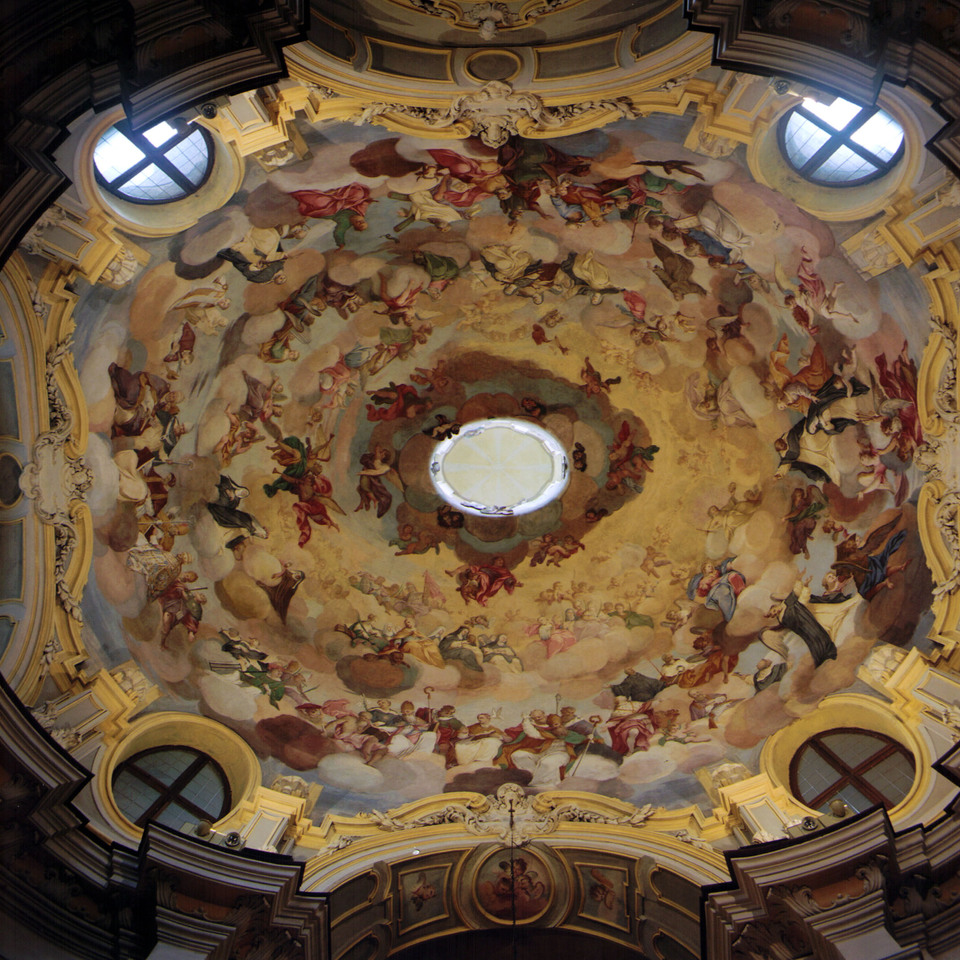
TheHistory
Church of Saint Mary Magdalene
According to a record notified by the Alba historian Giuseppe Vernazza (1745-1822), in 1251 the "Primary stone for edificar the church of S. M. Maddalena for the use of the Humiliati in Alba intra fossatum burgeti" was laid.
The first prior, documented in 1253, is Friar Rufino Cagnazerre. Further documentary records of that order in the city are from 1365, 1465 and 1573. Still referring to the medieval church ("In the village of Alba, in the houses of the house and church of St. Mary Magdalene of the Order of the Humiliated Friars of the village of Alba") is the 1365 ruling for the annual tithe payment pronounced by friar Iacopo Mascaro "provost of the house (Domus Dei) of the Humiliated Friars of Asti." Resulting in that document are the Humiliati in the city: friar Domenico Bogeno of Ceva provost, friars Bompetro Penacio and Pietro de monte of Gaurena.
The new monastery
Already in the 1446, after pontifical authorization with Bolla of 1445 by Pope Eugene IV, is blessed by the bishop of Alba Msgr. Alerino Rembaudi the cornerstone of the new monastery of St. Mary Magdalene, entrusted to the Dominican nuns, on the initiative of Margaret of Savoy (1390-1464), since 1418 the widow of Marquis Theodore II of Monferrato and later to become a Dominican tertiary nun after refusing the hand of Duke Filippo Maria Visconti of Milan.
The groundbreaking ceremony takes place in the courtyard of the marquis's palace, next to the pre-existing church, which had been granted to the noblewoman in 1422 by her stepson Giangiacomo who became effective marquis of Monferrato. The site is chosen because it is within the palace that was put in direct communication with the ancient cloister of the Humiliati. Margaret of Savoy-Achaia died in 1464, in a spirit of holiness. First Pope Pius V in 1566 allowed its worship by the nuns of the Alba monastery.
The Seventeenth Century
Pope Clement IX confirmed it in 1669, and his successor Clement X extended it to the entire Dominican order in 1671, setting the annual feast of Blessed Margaret on November 27. In 1689-90 the high altar was made. Notable celebrations in the city took place in 1693 for the repositioning of the mortal remains of the venerable woman, after an episcopal recognition in the previous year, in a reliquary urn donated by Duke Victor Amadeus II of Savoy. The body of the blessed remained exposed to devotion in the convent church until 2002, being transferred to the new cloistered monastery on Serre Street (named after her) for the completion of the canonical recognition of the body, which remained there.
The Church of St. Anthony Abbot
The church of St. Anthony the Abbot, first belonging to the Antonians, then passed to the Humiliati friars until the 16th century and later assigned to the Confraternity of the Pilgrims until 1656, was reported to be included on the side of the convent complex. It was still maintained with works in 1638-1639 by the brethren. An inventory of the furnishings in the sacristy of that sacred building was compiled in 1646. It is no longer extant.
The cloister
The cloister of the monastery was renovated around 1685-1690. The undertaking of the reconstruction of the monastic complex of St. Mary Magdalene began in 1731, with the first drawings by Bernardo Vittone revised by the architect Count Carlo Giacinto Roero. Work, implemented from 1733-1734 for the choir building, ended in 1749 for the Vittone-designed church. The cultic seat was consecrated by the bishop of Alba Msgr. Natta after 1750. Around 1785 work was carried out in the monastery complex, directed by architect Morari. In the sacred building of La Maddalena, in 1789, architect and Count Carlo Emanuele Rangone received from Abbot Girardi the habit and cross of the knightly Savoyard order of St. Maurice. The Alba palace of the Rangone nobles was located on Vittorio Emanuele Street (the "Maestra" street). One of their estates was in Diano d'Alba and several properties in Montelupo Albese, whose noble title they also held.
The French registry
In 1799 a list of all the convents in Piedmont was compiled by the French government. The following situation is recorded for the Magdalene Monastery in Alba: "Dominican nuns of St. Mary Magdalene, 23 nuns and 18 converse, 20,000 lira [reddito]" But with subsequent measures of the imperial government, the fate of the convent changed drastically: following the Napoleonic suppression of monastic orders, the nuns abandoned the convent complex in 1802. At that time, the abbess Angiola Teresa Inverardi, 24 professed and eight converse are reported to be present there, in a partially different situation than in 1799.
After the closing of the convent
During the period of closure, the buildings of the monastery complex were leased to private individuals, except for the church and choir, which were entrusted to canons Giuseppe Pollano and Carlo Pagliuzzi, later partly redeemed by them also with the cooperation of Count Giovanni Battista Veglio of Castelletto, mayor of Alba.
The nineteenth century
Following the Sabaud Restoration, it was only after complicated bureaucratic vicissitudes that a section of the convent was returned to the nuns by King Victor Emmanuel I of Savoy in 1817. In 1824 the entire convent complex reverted to the Dominican nuns at the behest of King Charles Felix of Savoy. In the following year the urn with the body of the blessed was solemnly returned to the church, in the presence of the king and his consort Maria Christina of Bourbon. However, in 1882, despite some opposition, the Municipality of Alba finally requisitioned the convent complex, applying the regulations of the Siccardi Law; so that the nuns again abandoned it for good. In 1889, based on a design by Eng. Molineris, the sleeve of the convent facing Vittorio Emanuele Street is rebuilt to house public schools.
The Exterior
In a heated and convincing tone, the noted German art historian Rudolf Wittkower (1906-1971) recalls his ecstatic visual encounter with the works in Piedmont by Bernardo Antonio Vittone.
The latter is the Turin architect (1705-1770) who designed the church of Santa Maria Maddalena in Alba.
Indeed, the astonishing and persuasive purposes of the 18th-century Baroque have immediate effectiveness, in a truly pregnant “spectacularity” of structural, spatial and decorative solutions.
But for Vittone these characterizations are accompanied by the problematic nature of the location of the buildings in the urban context.
The facade
Thus the former convent church of Magdalene, on central Vittorio Emanuele (“Maestra”) Street in Alba, is a defining presence as well as integrated in unison.
The (unfinished) terracotta facade is now a defining reference for views of the urban axis, but not too overpowering; likewise, the visual warmth of the “exposed” brick in its masonry articulations is an attractive but somewhat discreet element.
It is the architect Vittone himself who directly, in his Diverse Instructions, presents us with difficulties and characteristics of his design for the Church of the Magdalene, completed in 1749.
The constraints of the urban pre-existences and also the strong suggestion derived from the necessary presence of the high altar (erected in 1689-1690 by Giuseppe Maria Carlone and Francesco Piazoli of Turin) with the urn of the body of Blessed Margaret of Savoy-Acaia, played a decisive role in the Victorian conception.
This work of his in Alba follows, in executive chronological sequence, the church of S. Chiara in Turin (1745) and the parish church in Foglizzo (1748), precedes the church of the same name in Vercelli (1750), that of S. Antonio abate in Turin (1750) and that of S. Maria Assunta in Carignano (also 1750), interspersed with his design drawings for the convent and church of S. Maria Maddalena in Mondovì (1749) and for a chapel in the Annunziata in Turin (also dated 1749).
The partial solution of the facade of the Alba church (the building was not completed externally) has a sinuous and refined presence, derived from Borromini and more directly from Guarini.
Moreover, a persistence in Vittone’s religious building is the concave-convex movement. Earlier references to which to compare the elevation of the sacred building in Alba may be that of Guarino Guarini’s Carignano palace (erected 1679-1685) in Turin and especially the main front of the Turin church of the Immaculate Conception, still by Guarini (built in several stages between 1673 and 1697).
The wall conformations, which were to receive the stone slab cladding, mark in regular contrasts of chiaroscuro alignments, projections, vertical and horizontal elements.
The geometrically arranged “openings,” symmetrically arranged, appear as so many breaks in the continuous straight line of bricks. Only the ornamentation, the wide dark of the portal and the central lunette in the facade break such horizons, moved by the overall sinuosity and the interspersing of the pilasters.
Visit Duration
Ticket Price
Audioguides
Guided Visit
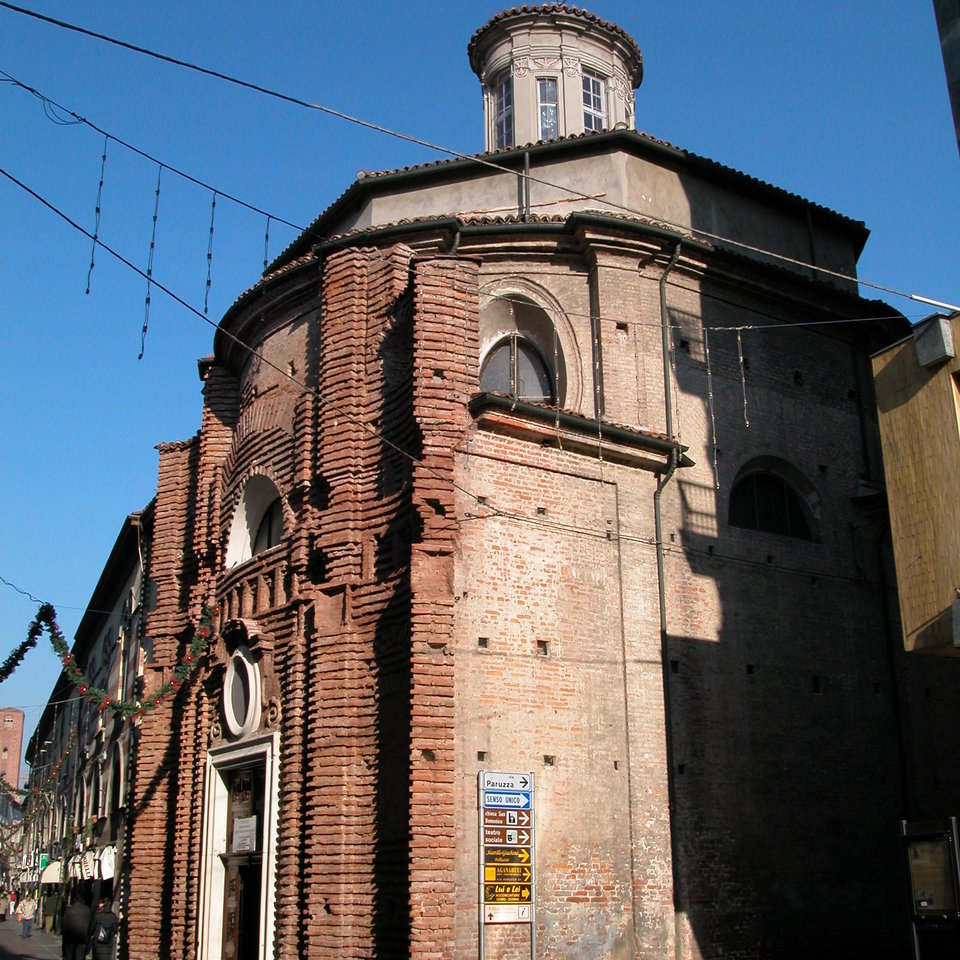
Made of terracotta bricks, the work of architect Bernardo Antonio Vittone.
The Interior
The interior of the sacred building is powerfully evocative, explicitly indicative of the fine design plan.
The hall has an overall rectangular plan, but with the prevalent ellipse of the dome. The structure is then lengthened in the large chancel (also almost rectangular, designed with architect Carlo Giacinto Roero count of Guarene and Vezza).
Internally it is flanked by the chapel of Blessed Margaret and a side altar. The voluminous room is dominated by the elliptical dome; so too is the oval (but much smaller) vault above the chancel.
The main space problems inside, the vast environment with the vault in an oval shape and the relationship to the considerable, partly pre-existing chorus, are resolved by Vittone with distinct planivolumetric installations, shielded (as required by monastic seclusion) by the monumental high altar and wrought-iron gratings that also attenuate, almost to the point of visually nullifying it, the irregularity of oblique course of the axis of Paruzza Street.
Light penetrates from the central lantern, radiating all around as far as the half-light of the chapel of Blessed Margaret of Savoy, which forms a lateral “breakthrough” in the uniform scope of the enveloping rhythm of the great dome frescoed by Milocco.
Also painted “a fresco” are the oval vault of the chancel (whose overall architectural design rises to further merit) and that, sensitively traversed by three lateral window splays, of the vast chancel, which, however, is the design work of 1732-1734 in collaboration with count architect Carlo Giacinto Roero (1675-1749), decorated by other artists.
The complex of the former Magdalene women’s monastery fits with dimensional peremptoriness into the urban fabric of the city.
The vast present courtyard, bordered by sleeves built on 2/3 of the perimeter at a constant height (two stories above ground with porticoes), was divided by an inner sleeve that determined two large courtyards connected by respective porches and doorways.
The former was larger, cloistered and representative; while the latter was intended for service activities.
Consequent to the nineteenth-century demolition of the dividing intermediate sleeve, a vast conchive surface is revealed, almost a quadrangular square, which is also overlooked, in the manner of a twentieth-century backdrop, by the building (also facing Accademia Street) erected in different phases between 1932 and 1937 on successive designs by surveyor Cesare Borgi.
Introduced by the eighteenth-century wooden doorway (with 18 panels carved in walnut, where the two largest bear in the center the insignia of three crossed arrows, a symbol linked to the devotion of Blessed Margaret of Savoy), one enters directly into the elliptical nave.
The frescoes
The visitor’s attention is certainly drawn to the large frescoes in the oval dome. This vast and “spectacular” fresco painting is the work of Turin painter Michele Antonio Milocco (1690-1772), made around 1748-1749.
Milocco (or Milloc), author of grotesques at the Royal Palace and Villa della Regina in Turin, would later be called to Alba in 1760 to illustrate the Glory of St. Theobald in the chapel dedicated to the saint in the cathedral.
Here in the Church of the Magdalene is the Glory of the Blessed Margaret the widely developed theme for the spacious elliptical surface, with dynamic, allusive compositional solutions, populated with single or grouped figures in a truly grand Baroque vortex.
The vaults
So too, the oval vault of the chancel is attributed, not without uncertainty, to Milocco himself. The fresco, with less emphasis is more modest in size, illustrates the Triumph of St. Mary Magdalene, repeating the usual compositional pattern of concentric circles of clouds and figures.
More convincing, of remarkable scenic effect, are the grand Baroque perspectives on the choir vault, completed in 1734 by painter Giacomo Guglielmo Rapa (or Rappa), previously engaged in both the Guarene castle and the vault of the Church of the SS. Annunziata, also in Guarene.
Here in the work in Alba, in the large painted surface, bordered by a strong cornice, in addition to the complex quadratures and some rocaille motifs, four monochrome angels can be discerned in respective ovals, presenting respective symbols of St. Mary Magdalene and Blessed Margaret of Savoy.
In contrast, the frescoes on the walls of the same room can be dated around the middle of the 18th century and assigned to the painters Matteo and Francesco Casoli of Guarene (Francesco,1704-1766, also active in the Guarene castle in 1729-1730 and possibly again in 1752-1753).
Also, the large chancel room houses forty-eight sought-after walnut stalls with volume-decorated armrests, kneelers, and backs inlaid with cross, shell, and diamond point motifs. It is valuable 18th-century work by an unknown author.
The crucifix
Above, on the tribune toward the back wall, the large walnut crucifix is clearly visible, marked by residual, large areas with original stucco for the pre-existing polychrome painting. It is a fine work, a pinnacle of late Gothic statuary in the Alba area and the entire province of Cuneo.
The Crucifix comes from the underground burial ground of the monastery and is the work of a Lombard sculptor, datable to 1440-1450. It was restored in 1969 by the relevant state superintendency, with operations of cleaning, full wood repair and consolidation of the partially painted surface.
On the opposite side, in the section of the chancel directly behind thechurch’s high altar is centrally located a large 17th-century painting by an unknown author depicting Jesus Christ and St. Mary Magdalene.
Returning to the church, the high altar should be admired, made in 1689-90 by “pica stone master builders” Giuseppe Maria Carlone and Francesco Piazoli, from Turin but from respective “Lugano” families.
Interlocutor to the contract for this work, representing the convent nuns, was the Alba native Francesco Domenico Barisano, a doctor of the House of Savoy and author of the book Vita della B. Margarita di Savoia Marchesa di Monferrato detta la Grande, published in 1692.
The altarpiece on the high altar
Also, in the church are worthy of attention:
- the altarpiece on the high altar (donated by King Charles Felix of Savoy in 1825), depicting St. Mary Magdalene and made by the Turin painter Giovanni Battista Biscarra (1790-1851);
- the 19th-century statues on either side of the same altar, depicting The Blessed Margaret the Nun and St. Agnes of Montepulciano;
- the late-empire embossed silver urn (a notable gift from Maria Cristina, widow of King Charles Felix of Savoy), made in 1840 by the Turin goldsmith Pietro Borrani to the design of the engineer Alfonso Dupuy and placed behind the altar of the side chapel of the Savoy blessed, above the earlier 17th-century urn;
- the 18th-century altarpiece, by an unknown Piedmontese painter, on the side altar of St. Rose, depicting the Madonna and Child, St. Dominic, St. Vincent Ferrer, St. Rose of Lima and angels.
Finally, the sought-after 18th-century wooden doorway outside on Paruzza Street is notable.
Visit Duration
Ticket Price
Audioguides
Guided Visit

Alba Underground Journey to the center of the city
Piazza Risorgimento, Alba, CN, Italia
Discover ↝

The parish church of St. John the Baptist
Piazza Elvio Pertinace, 2A, 12051 Alba CN, Italia
Discover ↝
Are you planning a trip in the Langhe region?
Let us help you design the perfect vacation, and live your stay like a true insider
Free
Service
Ask us
For advice
Free Service
Ask us
For advice
Free Service
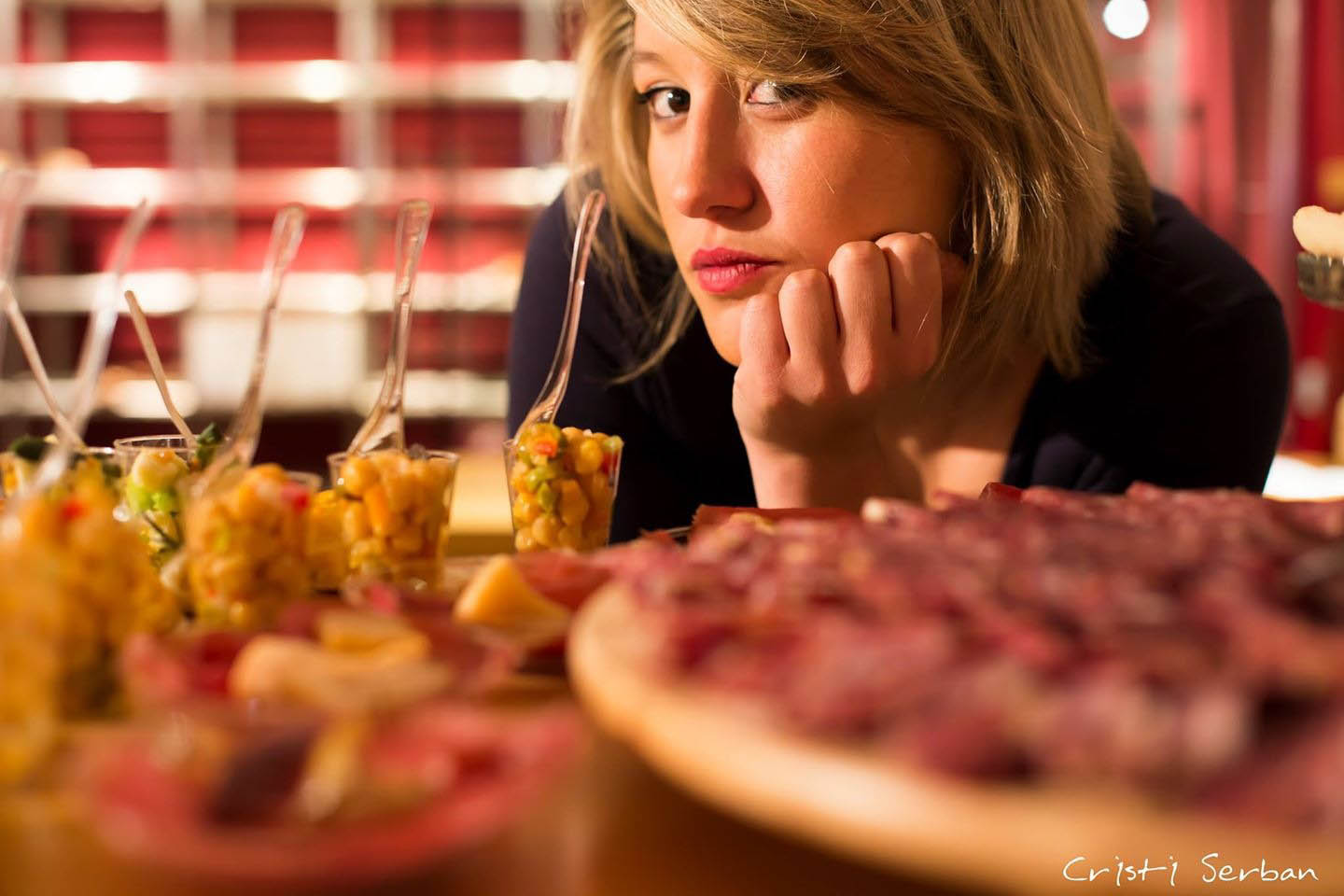
Fill in the form
reporting your interests and preferences
Receive our suggestions
directly into your inbox
And if it's not enough
we'll design a personalized trip!
